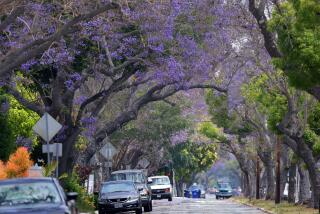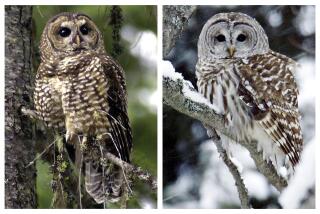Feathers Flying : Peafowl Have Some Folks Upset--So Does Plan to Trap Them
ARCADIA — Parading flocks of peafowl have ruffled the feathers of more than a few Arcadia residents this summer.
They say there are too many of the noisy, messy birds and want the flock thinned out.
But others say they chose the city as home partly to be near the showy, exotic animals. They say the birds’ numbers are dwindling and want them left alone.
Now, this clash of wildly conflicting views is heading for a showdown in City Hall. The City Council has scheduled a public hearing Sept. 1 to decide whether to begin a trapping program.
The peafowl flap began in early June, when some residents complained to the City Council about the spread of the birds, descendants of a small number set loose in the city more than 100 years ago. Originally, the peafowl (the collective term for the peahen and peacock) settled in an area called the Rancho Santa Anita tract, later flocking mainly to the Los Angeles State and County Arboretum. Over the years, they have moved farther north, sometimes crossing the Foothill Freeway (210) to eat flowers in well-manicured lawns and roost on the roofs of million-dollar homes.
The council asked staff for suggestions on how to control the peafowl population. A July 16 report outlined two methods. The traditional approach was to trap the birds and give them to a wildlife refuge or people living in rural areas. A more provocative idea was to conduct an “egg bounty day” during the spring and pay $5 for the first 100 eggs turned in.
Either way, Melody Wall, who lives near the arboretum on Harvard Drive, was outraged. She hurriedly collected about 340 signatures from neighbors who do not consider the birds a nuisance. She took the petition to the City Council on Aug. 4 and asked that the item be put on the agenda for discussion.
“The birds have been here since 1879, and we’ve never had residential trapping,” she said. “I don’t see any reason to start now. I think the (peafowl create) an ambience for the whole neighborhood which the city should support.”
If the birds create a problem for residents, they should call animal control officers, she said. At the upcoming hearing, Wall said, she will discourage the city from buying traps to capture the birds.
Representing the other camp, Scott Downie, who lives on an estate less than half a mile from the arboretum, said he will urge city officials to buy traps.
He estimated that up to 150 peafowl have migrated to his neighborhood in an area called the Oaks. He said he has spent about $2,600 to replace flowers eaten by the birds on his 53,000-square-foot property.
“They’re trespassing on private property,” he said. “There is no sign on my property that says, ‘Peafowl Welcome.’ ”
*
Downie said the birds fly to his neighbors’ roofs, squawk and wake up everyone in the neighborhood. They also leave droppings the size of silver dollars, he said.
He added that he is not advocating destroying the peafowl but that he thinks the city should relocate them “to other areas where people really want them.”
The two first pairs of peafowl were brought from India to the San Gabriel Valley by Arcadia land speculator Lucky Baldwin in 1879. The descendants of those two early pairs, and others imported elsewhere in the area, have adapted and rapidly reproduced.
Officials of the Los Angeles County animal care and control shelter in Baldwin Park said no one has conducted an accurate count of the peafowl but, judging by reports from residents, they estimate that the population in Arcadia is between 500 and 700 and growing.
The peafowl dilemma has apparently intensified recently at the 127-acre arboretum, Deputy Director John Provine said. There are no longer any natural predators such as coyotes to keep the peafowl population under control, he said.
For years, the arboretum has trapped peafowl and given them to people living in rural areas, such as Ontario, Lancaster and Santa Barbara, Provine said. In June, when the birds began congregating at the lushly planted entrance, a more aggressive plan was implemented. Employees were paid $2 for trapping a bird in a cage set up near the home demonstration garden, he said.
The project was discontinued the same month after some neighbors complained that the birds were disappearing, he said.
Feral peacocks roam in a several areas of Southern California, including La Canada Flintridge, Mission Viejo, Anaheim Hills and Palos Verdes Estates. Two of those cities have experienced problems similar to Arcadia’s and have found different solutions.
Almost seven years ago in Palos Verdes, there was suspicion that birds were poisoned when nine were found dead. Now the city counts the birds three times a year, and if the population exceeds 42, residents are allowed to trap them. The city provides a trap for a $10 rental fee. The humane society does the trapping.
In 1988, La Canada Flintridge loaned traps to residents who did not want the peafowl around. Assistant City Manager Mark Alexander said the city stopped the program after a year and a half because residents complained that the peacock population was shrinking. But there have been no complaints from either side in about two years, he said.
More to Read
Sign up for Essential California
The most important California stories and recommendations in your inbox every morning.
You may occasionally receive promotional content from the Los Angeles Times.










